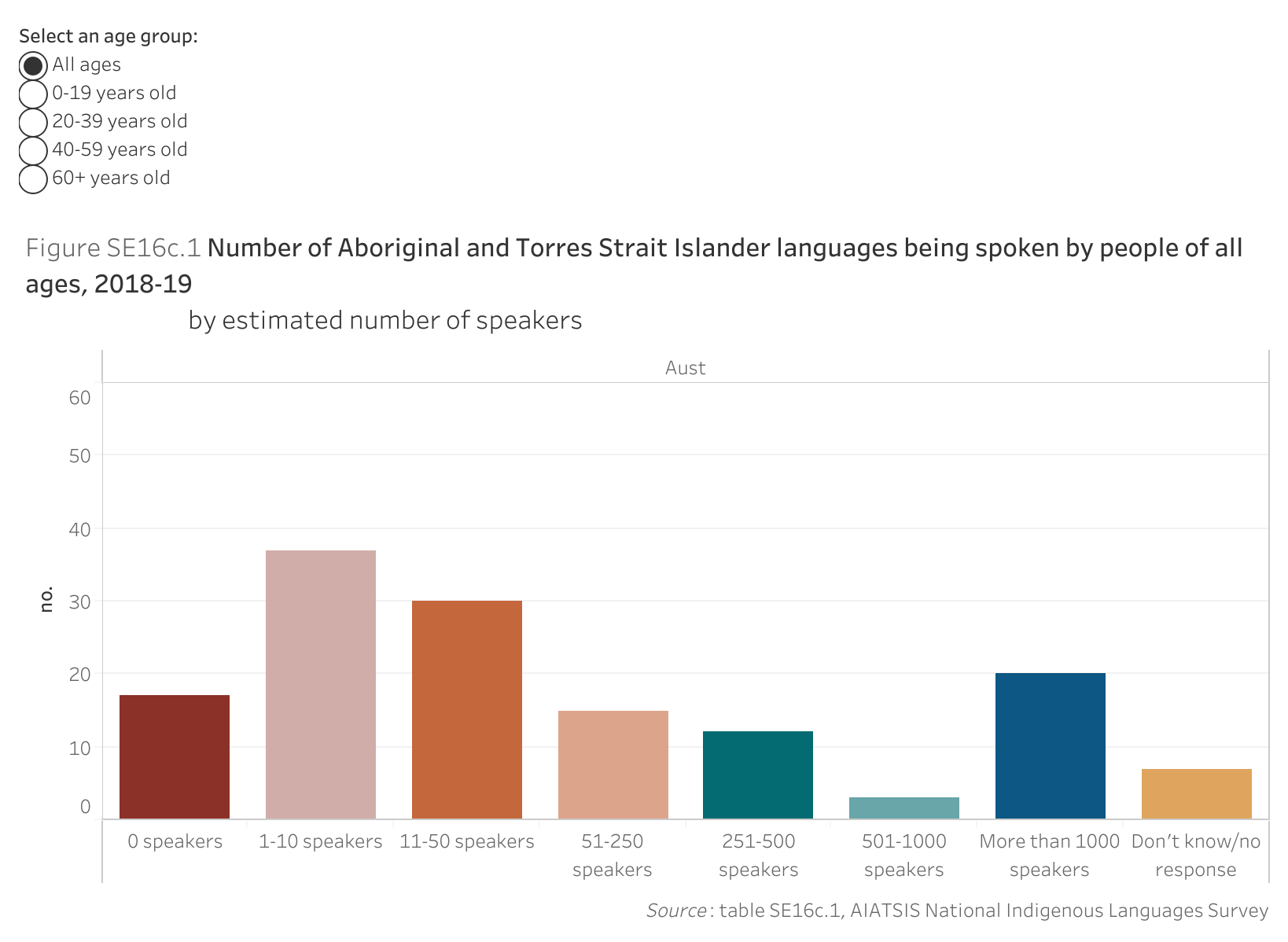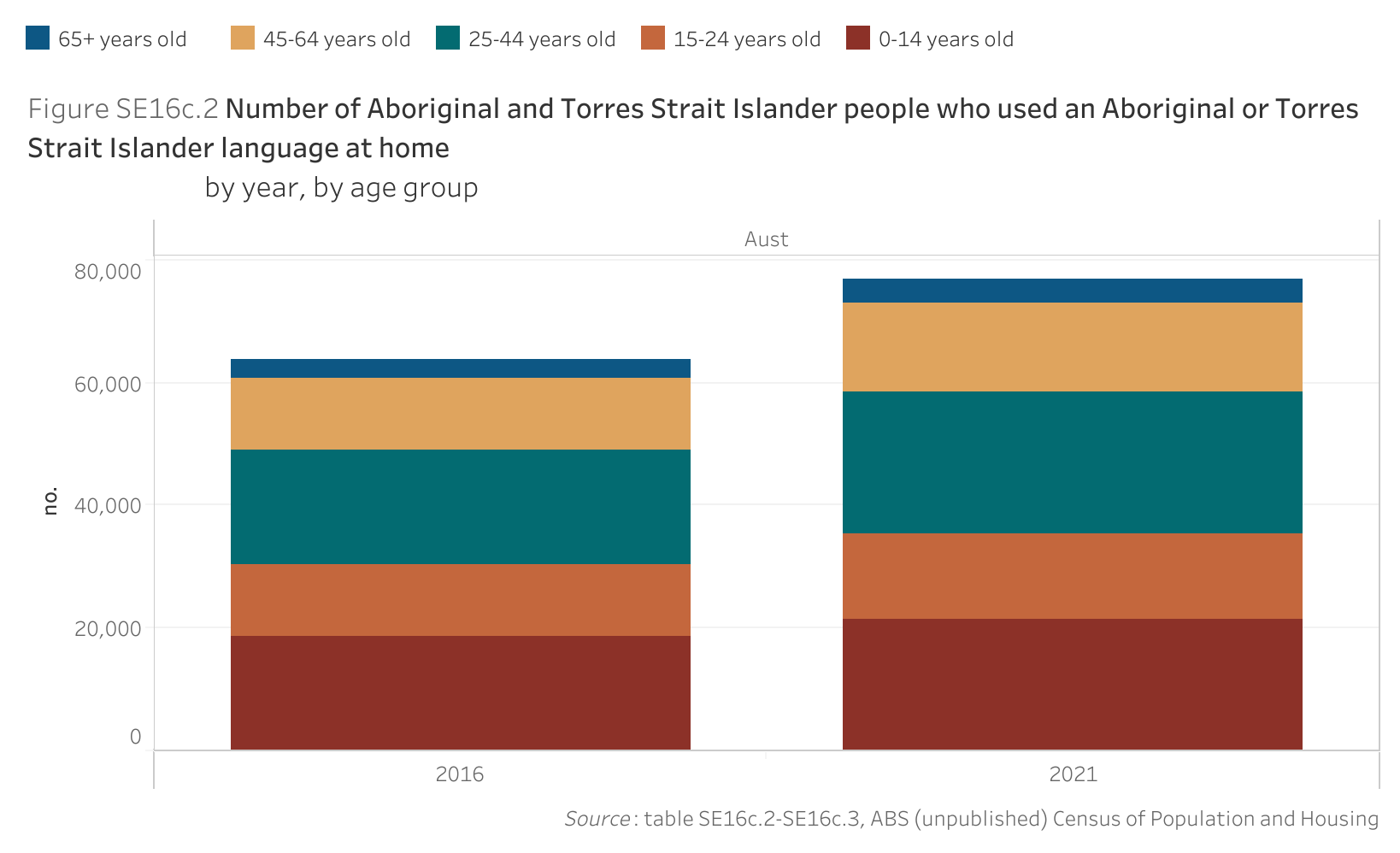Driver
Number and age profile of the speakers of Aboriginal and Torres Strait Islander languages
Including children
Dashboard snapshot: The data below are the most recent at the time of preparing the July 2023 report. Please go to the dashboard to access the current data.
Measure 1
Number of Aboriginal and Torres Strait Islander languages spoken, by estimated number of speakers, by age group
Nationally in 2018-19, of the 141 Aboriginal and Torres Strait Islander languages for which data were available, almost half (67) were reported to have had 1-50 speakers and 17 had no speakers, while 20 languages had more than 1000 speakers (figure SE16c.1).
For Aboriginal and Torres Strait Islander people aged 0-19 years, there were 60 languages reported as having no speakers. Whereas for people aged 60 years and over, this decreased to 18 languages reported as having no speakers.

| Description3 | 2018-19 |
|---|---|
| 0 speakers | 17 |
| 1-10 speakers | 37 |
| 11-50 speakers | 30 |
| 51-250 speakers | 15 |
| 251-500 speakers | 12 |
| 501-1000 speakers | 3 |
| More than 1000 speakers | 20 |
| Don't know/no response | 7 |
Measure 2
Number of Aboriginal and Torres Strait Islander people who used an Aboriginal and Torres Strait Islander language at home, by age group
Nationally in 2021, 76 978 Aboriginal and Torres Strait Islander people were reported as using an Aboriginal and Torres Strait Islander language at home (figure SE16c.2). Almost one-third of language users were aged 25-44 years (22,972) and over one-quarter were aged 0-14 years (21,952). A further 1457 non-Indigenous people were reported as using an Aboriginal and Torres Strait Islander language at home (table SE16c.2).
Since the 2016 baseline year, the number Aboriginal and Torres Strait Islander people reported as using an Aboriginal and Torres Strait Islander language at home increased 20.7 per cent (from 63,753 people), with increases across all reported age groups.
Data are reported for the 10 most commonly used Aboriginal and Torres Strait Islander languages at home, as recorded in the 2021 Census (table SE16c.3). Of these, the most commonly used by Aboriginal and Torres Strait Islander people were Yumplatok (Torres Strait Creole) (7596 users) and Kriol (7403 users).

| Description4 | 2016 | 2021 |
|---|---|---|
| 65+ years old | 2,935 | 3,883 |
| 45-64 years old | 11,701 | 14,595 |
| 25-44 years old | 18,739 | 22,972 |
| 15-24 years old | 11,657 | 13,936 |
| 0-14 years old | 18,719 | 21,592 |
Indicator data specifications
Related outcome: | Aboriginal and Torres Strait Islander cultures and languages are strong, supported and flourishing. |
|---|---|
Related target: | By 2031, there is a sustained increase in number and strength of Aboriginal and Torres Strait Islander languages being spoken. |
Indicator: | Number and age profile of the speakers of Aboriginal and Torres Strait Islander languages, including children. |
Measure: | There are two measures for this indicator. Measure 1 Number of Aboriginal and Torres Strait Islander languages spoken, by estimated number of speakers, by age group Numerator — the number of Aboriginal and Torres Strait Islander languages spoken, by estimated number of speakers, by age group and is presented as a number. Measure 2 Number of Aboriginal and Torres Strait Islander people who used an Aboriginal and Torres Strait Islander language at home, by age group Numerator — the number of Aboriginal and Torres Strait Islander people who used an Aboriginal and Torres Strait Islander language at home, by age group and is presented as a number. |
Indicator established: | National Agreement on Closing the Gap July 2020 |
Latest dashboard update for the indicator: | 15 June 2023 |
Indicator type: | Driver |
Interpretation of change: | Measure 1 and 2 - A high or increasing number (in total and across each language) is desirable. |
Data source(s): | Measure 1 Name: Third National Indigenous Languages Survey 2018-19 (NILS3) Frequency: Periodic. National Indigenous Languages Survey are conducted at irregular intervals: NILS1 in 2004-05, NILS2 in 2014-15 and NILS3 in 2018-19. Documentation (links): https://aiatsis.gov.au/research/current-projects/third-national-indigenous-languages-survey Measure 2 Name: Census of Population and Housing Frequency: Five-yearly Documentation (links): https://www.abs.gov.au/statistics/people/aboriginal-and-torres-strait-islander-peoples/language-statistics-aboriginal-and-torres-strait-islander-peoples/2021#language-speakers |
Data provider: | Measure 1 Provider name: Australian Institute of Aboriginal and Torres Strait Islander Studies (AIATSIS) Provider area: Languages Measure 2 Provider name: Australian Bureau of Statistics (ABS) Provider area: Census |
Baseline year: | Measure 1 2018-19 Measure 2 2016 |
Latest reporting period: | Measure 1 2018-19 Measure 2 2021 |
Disaggregations: | Measure 1: Australia, by estimated number of speakers, by age group. Measure 2: State and territory and Australia, by age group Australia, by top 10 languages, by age group. |
Computation: | Counting rules Measure 1 Data are for the number of Aboriginal and Torres Strait Islander languages spoken. Aboriginal and Torres Strait Islander languages includes language varieties in the AustLang database. Languages are coded according to the AustLang database of Aboriginal and Torres Strait Islander language varieties. (AustLang is a thesaurus of Aboriginal and Torres Strait Islander languages and peoples, maintained by AIATSIS.) The AustLang database has been assembled from a number of referenced sources. AustLang can be searched with language names, placenames and via the codes. AustLang has links to a number of online resources. AustLang includes many variant forms of language names. For the number of language speakers, NILS respondents were provided a multiple-choice list with ranges of numbers of speakers of each language group. Measure 2 Data are for Aboriginal and Torres Strait Islander people enumerated in the Census that reported having a usual residence in Australia. (For context, data are also provided on the number people who spoke an Aboriginal and Torres Strait Islander language at home who were non-Indigenous or their Indigenous status was not stated.) Includes respondents who indicated that they used an Aboriginal and Torres Strait Islander languages at home. The Census asks, 'Does the person use a language other than English at home?'. Respondents can use a mark box to indicate the language they use at home or write the name of the language they use in a free text field. Responses to this question are coded to the Australian Standard Classification of Languages (ASCL). Aboriginal and Torres Strait Islander languages are those classified as ‘Australian Indigenous Languages’ in the ASCL and include:
Disaggregations (measure 2): State and territory: Geographical variables are based on a person's place of usual residence. The top 10 languages: are the top 10 Aboriginal and Torres Strait Islander languages, nationally, reported in the 2021 Census. The top 10 languages exclude Aboriginal and Torres Strait Islander languages with a ‘not further defined’ (nfd) or ‘not elsewhere classified’ (nec) ASCL code. These are supplementary codes in the ASCL and are not individually identified languages. Users of languages classified to nfd or nec codes are counted in the total number of Aboriginal and Torres Strait Islander language users. |
Data quality considerations: | Measure 1 For the NILS, AIATSIS collected data from respondents who are thought to have sufficient knowledge of language communities in order to collect the data. These respondents include communities, language centres and other organisations carrying out language projects; and linguists who specialise in Aboriginal and Torres Strait Islander language. There are several factors needed to be considered when interpreting the data:
Other limitations of the data gathered include:
Measure 2 The ABS Post Enumeration Survey estimated that the 2021 Census had a net undercount of 170 752 Aboriginal and Torres Strait Islander people (people that should have been counted in the Census but were not), or 17.4 per cent of the Post Enumeration Survey population estimate. In the 2021 Census, the Language Used at Home (LANP) question wording was amended to include the word 'use' rather than 'speak' to better accommodate members of the community who use sign language. An enhancement to the online form presented a check box for Aboriginal and/or Torres Strait Islander language for those respondents who identified as Aboriginal and/or Torres Strait Islander in the Indigenous status question. To improve the data collected on Aboriginal and Torres Strait Islander languages, the person also had the option of specifying the language. Census data do not distinguish between languages used at home and heritage languages. The Census language question only allows for one language to be reported. Census data do not distinguish between speaking a language fluently and speaking only a few words. For Aboriginal and Torres Strait Islander people, the non-response rate for the Language used at home (LANP) question was 5.0 per cent in the 2021 Census. All data values have been randomly adjusted using perturbation to avoid the release of confidential data. Discrepancies may occur between sums of the component items and totals. Proportions/rates calculated for small populations should be used with caution. |
Future reporting: | A fourth National Indigenous Languages Survey has been funded to be conducted by 2024. Additional disaggregations required for future reporting:
|
